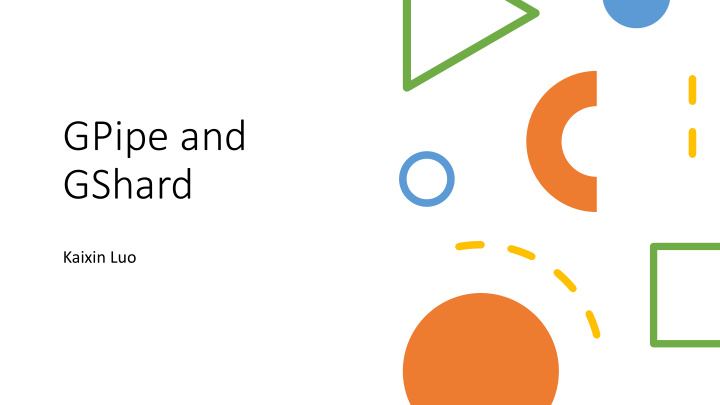



GPipe and GShard Kaixin Luo
Motivation • The more Computational power you spent, the better model you get
GPipe’s Idea • Commonly known parallelisms : • Data Parallelism • Model Parallelism • Proposed: • Pipeline parallelism
What is Pipeline parallelism?
Formally speaking • Partition mini batch into micro batches For forward pass: • • Executes the model as usual • For backward pass: • Sum the gradient of micro batch into mini batch gradient
Introducing GPipe Library • Open source • Implemented under Lingvo
GPipe Interface • Any model could be treated as a sequence of layers • Each layer has a forward function f, with weights w and optional cost function c • Given K devices, the forward function F for each partition is the combination of f[i] to f[j] • The back propagation could be computed by symbolic differentiation • The cost of each partition could be the sum of the layer cost
Algorithm • Given K as the number of accelerators: • The network will be partitioned into K “pieces” • Communication primitive inserted for each partition • The partition algorithm will minimize the variance of estimated communication cost. • Given N as the size of the batch and M as the number of the micro batches: • Forward pass computes as normal • In the backward pass, sum up the gradient of micro batch into mini batch gradients
Performance • Tested model: • AmoebaNet • Transformer • Measures • Scalability • Effifiency • Communication cost
Scalability
Efficiency
Communication Cost
Test result for AmoebaNet
Test result for Transformer
GPipe is not panacea • Need a smart partition for micro batch, sparse or imbalanced partition will hurt the overall performance • Bubble time is an issue when the data set is too small(M>4K). • The model partition is not flexible when the model is complex(GShard)
GShard
What is sharding? • In database, it is breaking big table into pieces and store them in different place. • But, how about neural networks?
Motivation • scaling a model that is already big enough.
Challenges for scaling • Architecture support • Computation cost vs model size • Model representation
Proposed design principle • SPMD XLA compilers • Sublinear scaling for model design • Model Abstraction
SPMD Compiler
Sublinear model design
Model: Transformer with MoE Layer
Mixture of Expert Layer • A group of parallel feed forward neural networks. • The gating algorithm will dispatch the weight.
Gating
FLOPS Analysis
Shallow dip about einsum • Matrix multiplication: • Einsum(“ab,ba->aa”, mat1, mat2) • Matrix Dot: • Einsum(“ab,ab->ab”, mat1, mat2) • Matrix transpose: • Einsum(“ab->ba”, mat1) • Matrix sum: • Einsum(“ab->”, mat1)
FLOPS Analysis • Assumption : • Given G as the group number, D as the device number, E as the expert number, the rest are constances. • number of tokens per device N/D=O(1) is constant1 • G=O(D),S=O(1) and N=O(GS) =O(D) • M=O(1),H=O(1) • E=O(D) • C=O(2S/E) =O(1/D),D < S and is a positive integer
FLOPS Analysis
GShard APIs • Replicate(tensor): replicate the tensor across partitions • Split(tensor, split_dimention,num_partitions): split tensor according to split_dimensions into num_partitions portions • Shard(tensor, device_assignment): generalized split and allowing multi-dimension split and specifying the placement of each dimension
MoE forward computation using GShard
GShard communication APIs • CollectivePermute: • Change sharded tensor device order among partitions • AllGather • Concatinates tensors • AllReduce • Elementwise reduction among partitions • AllToAll • Logically split the tensor according to the dimension and send to different participants, it is efficient in TPU device network
Results
Results
Reference: • Huang et al., GPipe: Efficient Training of Giant Neural Networks using Pipeline Parallelism • Lepikhin et al., GShard: Scaling Giant Models with Conditional Computation and Automatic Sharding • https://www.youtube.com/watch?v=9s2cum25Kkc • https://www.youtube.com/watch?v=1VdEw_mGjFk
Take Care and Thanks
Recommend
More recommend